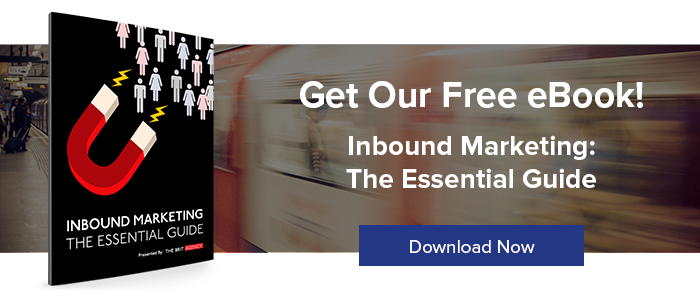Over the past few years, B2B marketing dollars have shifted away from traditional outbound advertising and brand awareness marketing, towards more accountable, results-driven, Inbound Marketing where the return on investment (ROI) is paramount.
This has changed the typical B2B marketing conversation to something like, “If I spend x on this marketing program, what returns can I expect to see?”.
Don't get me wrong, there’s no problem in having some of your marketing program focused on brand awareness activities, but when a disproportionate amount of marketing time, effort, and budget, is used on advertising and outbound programs – there’s going to be definite wastage and the ROI needs to be questioned.
But once you and your management team, starts asking these sorts of questions - "what is the ROI of a trade show?" or "how many leads did a trade ad get?", then the game changes.
By focusing on the ROI of B2B Inbound Marketing, you can get rid of waste. You'll need to focus on managing your marketing budget from the perspective of inputs and outputs. You can plan your output goals – such as the number of leads you need to generate "x" amount of sales, and then build your Inbound Marketing program so it can deliver on that goal.
Remember, B2B buyer's behaviour has changed. Today the typical B2B buyer expects engaging and personal brand experiences throughout their relationship with a company. They are used to connecting on social media, getting replies to tweets, having immediate access to information, customer service chats, online comparison researching and more, all in an instant on their own time. Therefore, you will need to engage these leads and customers to stay relevant, and build interest - but having it measurable is really important.
B2B Inbound Marketing helps determine the success of your marketing efforts with data, critical to calculating ROI, but what else can help with?
I looked at 10 common marketing challenges B2B companies have, and found there is a B2B Inbound Marketing solution to them all.
1/ Spending on marketing activities that doesn't produce an ROI has to stop.
It's essential to focus your budget and time on your marketing ROI, and put aside things that can't be measured for success. Tracking all your activities and measuring them against the number of leads generated would be a good start, and the principals of Inbound Marketing will really help you there.
2/ Your management team may have unrealistic expectations for your marketing activities.
Inbound Marketing is goal-based and therefore management should be involved in the setting of those goals. Once marketing data becomes available, realistic metrics will start to lead the discussion, and SMART goals can set. (SMART goal setting means Specific, Measurable, Attainable, Relevant and Time-Based, is an effective process for setting and achieving your business goals).
3/ Get everyone on the same page!
You may not be able to implement some better quality marketing programs, because there are too many differing opinions from other people and departments in the company – on how to spend your marketing budget.
Here, I’m generally referring to the sales department wagging the tail for marketing. For example, sales can be very focused on building and maintaining relationships, and therefore they’d like marketing dollars spent on client facing activities: golf tournaments, gifts, hospitality and client hosted events. This can be expensive, ineffective and often without any ROI.
Today this doesn’t work. B2B companies with traditional sales and marketing departments have to move forward to work more effectively together, by adopting terms of engagement, share proper business goals, and even have a SLA (service level agreement) about how they should handle leads. Inbound Marketing and Inbound Sales has a defined methodology on how to work together.
4/ Short term reactive marketing that doesn’t benefit the long term.
As we all know, there are always new shiny things that can pull at our budgets, tugging us away from our planned marketing activities. The danger here, is that we can bounce around adopting new marketing tactics that just don’t deliver any tangible results, especially in the long-term. This impacts the quality of your overall B2B marketing, as there is no ‘steady as she goes’ long-term approach.
Inbound Marketing on the other hand, is a long-term play, the more quality SEO keywords, blogs and content you develop in the near term - the more this strategy will pay off handsomely in the long-term. Inbound Marketing is a must-do activity for now to build success for the long-term. You should start as soon as possible and never stop.
5/ Lack of integration and coordination.
Integrated marketing was one of those terms used a few years ago to describe marketing tactics that can be connected and related, usually by brand and message. But few companies ever truly integrated their activities. The technology, the processes and the skills, were never really there to make it easy to put into practice.
Inbound Marketing on the other hand, allows us to truly integrate all the tactics into one Inbound methodology. Everything from blogging, social media, SEO, PPC, events, website content and design, email marketing, demand generation, lead generation, lead nurturing, and analytics, can all be beautifully integrated into one technology platform. This brings all these disparate marketing tactics together for the first time.
6/ Singing the same song.
Don’t rely on one tactic to do the job for marketing. I’ve seen this too often. A company will use one tactic – see some results and get addicted to it.
AdWords is a good example here. Some companies put over 50% of their entire marketing budget into doing ridiculous amounts of PPC ads with Google. And they often do it badly. AdWords is like candy, sure it will deliver the rush of leads, but getting off it to eat sensibly is really hard. There are better and cheaper ways to generate leads than PPC that will pay off better in the long-term.
You must not get addicted to the easy results AdWords delivers. So use Inbound Marketing to diversify your digital marketing mix and focus on making your website better able to generate quality organic traffic and leads.
7/ Your website is probably old, out-of-date, and poorly maintained.
Remember that really expensive company website you developed 6 years ago. It was not only a painful and very expensive process, but it took a year to build. Mention a new website project to your management team and they shudder, they probably don’t want to update the site on this year’s budget.
Well guess what? You probably need a new website.
Fortunately, these days, Inbound Websites can be built on an easy-to-use CMS platform, a lot cheaper and quicker using the principle of "minimum viable scope" and continuous improvement. And of course, Inbound Websites are totally focused on Inbound Marketing and lead generation, an essential tool for marketing. The key for management approval might be to show that the website ROI can be measured, by monitoring the growth of traffic, leads and sales.
8/ Not enough leads.
A big challenge for B2B companies, that is also associated with the existing website, are its lack of lead generation capabilities and the lead nurturing process.
If the website isn’t specifically designed for Inbound, then the lead generation and nurturing process is probably poor. As a result, sales think any leads that marketing has generated are a waste of time, and the whole dialogue around the role of lead generation is usually unhealthy.
By adopting Inbound, marketing and sales have to work together, leads have to be nurtured by marketing (MQLs), and sales qualified leads (SQLs) have to be taken over by sales and moved through the Inbound Sales process.
There are some big improvements happening in B2B sales departments, with the adoption of Inbound Sales providing a clearer sales process to follow.
9/ Finding value in marketing.
Many marketing departments are unable to communicate the value of marketing to management. This is a challenge that I think is symptomatic of management itself.
Often, in order to save money, a junior marketing person is hired by management to do the job of marketing, and consequently these younger inexperienced managers may lack the required skills and leadership required to properly promote the value of marketing to the rest of the company.
Inbound Marketing can help by providing all the tools and data necessary for a junior marketing person to start showing results to the management team. No matter who you are – you have to think ROI. The penny will drop with the correlation between actions and results, inputs and outputs. This invariably leads to better communications and a healthier role for marketing within the organization.
10/ No game plan.
Without a planned game plan – marketing won’t deliver the results you want because data isn't used to set the goals.
I recommend converting to Inbound as quickly as possible, as your business and your lead generation program, might be in need of some better planning. But sometimes it like turning a massive oil tanker around in the ocean – it can take time.
Once you’re onboard with an Inbound program you should be able to establish what a lead pipeline for success looks like – simply put, what can you forecast for website traffic, website leads and how your websites contribution to sales.
You’ll need to make assumptions at first, such as total target audience size, industry average conversion rate norms, amount of website traffic you need to generate the number of leads for your goal, % conversion rates for MQLs and SQLs, and finally closing rates for sales. But, assumptions are a starting point, and because your Inbound program is focused on data - you can make adjustments in the future based on what you actually measure.
With this data you should be ready to build an effective pipeline model, a lead generation program that is totally measureable and accountable, with ROI that can be reported up to the management team.
THE BRIT AGENCY is a B2B Inbound Marketing Agency providing Inbound Marketing, Inbound Website Design and Inbound Sales services to companies around the world. We're focused on growing website traffic, qualified leads and sales, using the Inbound lead generation and marketing automation process.
THE BRIT AGENCY is a certified Gold Tier Hubspot Partner, a HubSpot COS certified Inbound Website Design Agency, a Shopify eCommerce Partner, and a certified "Google Badged Agency Partner". We have offices in Toronto and Barrie, Canada, and Salisbury, UK.


